Subjects:
- Preface
- Intelligent battery sensor
- Components and measurement principles of the battery sensor
- Charging and replacing the battery
Preface:
In modern vehicles, the charge status of the alternator is adjusted to the circumstances. The alternator is controlled from the engine ECU and receives signals to charge more or less. The alternator generates energy as a magnetic field is created between the rotor and stator. The greater the magnetic field, the more force required to turn the rotor. Generating a large amount of charging current therefore costs energy and fuel.
- The idle speed can be increased when the battery is almost empty when there is insufficient recharging possible;
- During maximum acceleration, the alternator is temporarily not controlled in order to use all the generated torque for propulsion;
- When decelerating (engine braking), the ECU controls the alternator to maximum effect, so that the vehicle's kinetic energy is used to generate energy in the alternator. The figure shows the indication of the maximum battery charge (12 volt system).
The signal from the intelligent battery sensor is used to determine the charge status of the battery. This is one of the most important data to determine to what extent the alternator should be controlled.
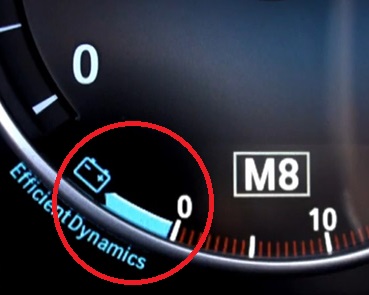
Intelligent battery sensor:
Modern vehicles are almost all equipped with a battery sensor, often known as an IBS (Intelligent Battery Sensor), current sensor or battery monitor. In this article we will refer to the term “battery sensor”. The battery sensor works in close cooperation with the Battery Monitor System (BMS) in the vehicle. This is especially true for vehicles with a start and stop system. In these vehicles, the battery is repeatedly put under heavy strain as the starter motor is activated several times per trip to start the engine. That is why an AGM battery is often chosen in such vehicles instead of a traditional lead cell. An AGM battery is more resistant to repeated discharge and charging.
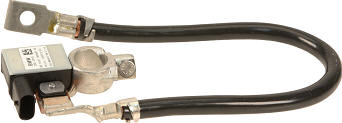
The battery sensor is integrated into the ground cable, which is attached between the negative terminal of the battery and a ground point on the bodywork or chassis. On the battery sensor you will find a plug with two or more wires. One wire leads directly to the positive terminal of the battery, and a second wire is for communication.
Inside the battery sensor housing is a circuit board with a microprocessor and a controller that measures voltage, current, temperature and time. The data from this Electronic Control Unit (ECU) is often transmitted via a LIN bus to the alternator and the comfort control unit (BCM) or the engine control unit. The gateway is often located between the battery sensor and the BCM or engine control unit to translate the LIN bus message into a CAN bus message. This is discussed further in the section “diagnosis on the intelligent battery sensor”.
The battery sensor monitors the condition of the battery and measures the following parameters:
- The battery voltage.
- The current with which the battery is charged and discharged.
- The temperature of the battery.
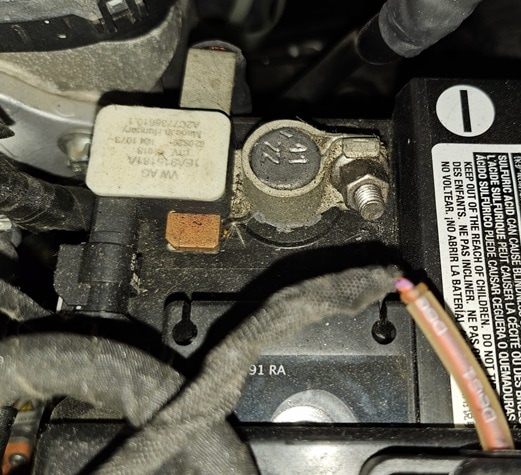
The battery sensor sends this data to the engine control unit or BCM. Using this data, the ECU (Electronic Control Unit) calculates the following:
State of charge (SOC) of the battery. By measuring the outgoing current to the consumers and the incoming current to the battery, it can be determined how much energy is still available in the battery.
Condition (State Of Health, SOH) of the battery. The battery voltage and discharge current are compared to assess the quality of the battery. During starting, up to 60 A of current can be drawn from the battery with a small petrol engine or up to 120 A with a heavier diesel engine. The extent to which the battery voltage drops indicates the level of internal resistance in the battery. If the voltage drops from 11,5 to 10 volts at a current of 60 A, this is acceptable. If the voltage drops from 11,5 to 8 volts with the same starting current, this indicates too high internal resistance in the battery and requires replacement.
Quiescent current during standstill. This detects a disturbance of the quiescent current, for example by an unauthorized consumer. The driver will receive a notification during the next trip if an increased quiescent current is detected.
Components and measurement principles of the battery sensor:
The housing of the battery sensor and the ground terminal are often integrated into one whole. The ground cable can also form a whole with the battery sensor or be attached with a screw connection. Inside the battery sensor there is a shunt resistor with a very low resistance value. By measuring the voltage difference across this shunt, the current can be calculated. In combination with the battery voltage, the power with which the battery is charged or discharged can be calculated.
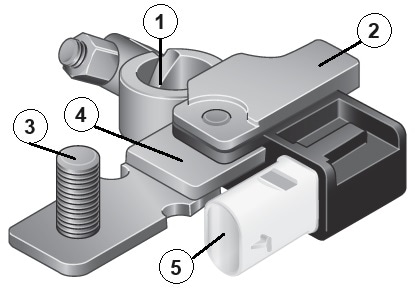
1. Pole clamp ground pole;
2. Battery sensor;
3. Vehicle ground connection;
4.Shunt;
5. Plug connection for B+ and LIN bus.
The shunt resistor is placed in series between the ground connection of the vehicle and the negative terminal of the battery. All current to and from the battery passes through this shunt. Due to the low resistance value, little voltage is consumed in the shunt.
The level of this voltage is converted into a current in the microprocessor, together with the known resistance value of the shunt:
- A large voltage drop across the shunt indicates a large current.
- A low voltage drop indicates a low current.
In the attached image we see a diagram in which the resistor R represents the shunt and the current I represents the discharge current during the discharge of the battery. The voltmeter, which is placed in parallel across the shunt resistor, illustrates how the measuring electronics in the battery sensor measures the voltage difference across this shunt.
The image below provides an overview of the locations where temperature, voltage and current measurements take place.
The shunt resistance is indicated by number 5. The voltage difference (V) across the shunt is read as current (A). This data is sent via the LIN bus to the DME/DDE, which are the designations for BMW's petrol engine (DME) and diesel engine (DDE).
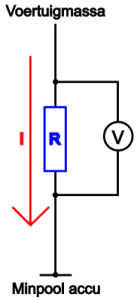
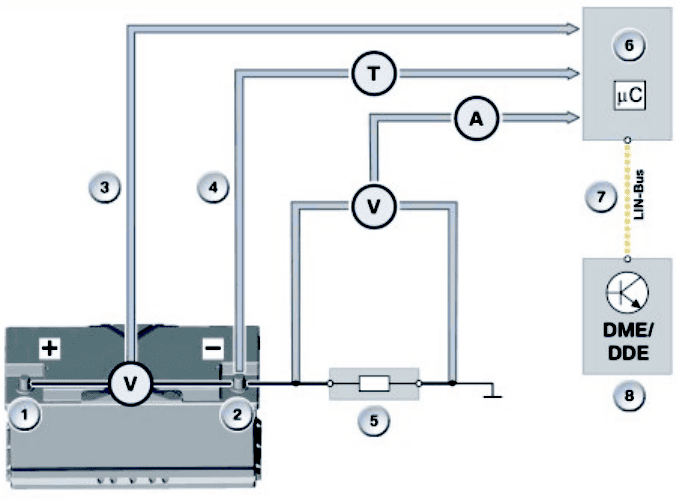
1. Battery positive pole;
2. Battery ground terminal;
3. Measuring battery voltage;
4. Measurement of battery temperature;
5. Measurement of the current using a shunt resistor;
6. Microprocessor in the intelligent battery sensor;
7. LIN bus communication wire
8. Engine control unit
Charging and replacing the battery:
The battery management system uses the battery sensor to measure the current flowing to and from the battery and store this information in memory. When the battery needs to be charged or if a starting aid is used, it is important that the battery charger is not connected directly to the battery terminals, but to the charging points. The battery sensor is located between these charging points and the battery terminals and can only measure the energy flow when the battery charger is connected to the charging points. If the battery charger is connected directly to the battery terminals, the BMS memory will indicate that the battery is (almost) empty, while in reality it is fully charged. The alternator will then overcharge the battery, after which the system will malfunction. The images below show a battery charger connected directly to the battery and to the charging points under the hood.
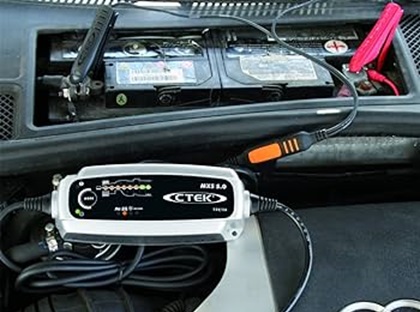
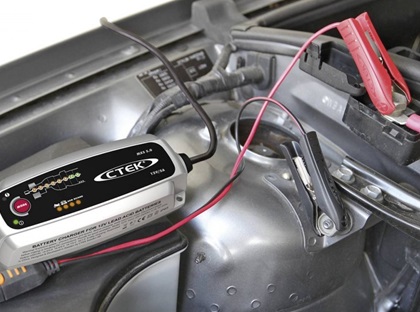
After replacing the battery, the battery must be registered on a vehicle equipped with a battery sensor. In the workshop it is also called “learning” or “coding”. Battery management takes into account:
- aging of the battery. The charging current of an older battery with an increased internal resistance can be increased;
- the capacity and cold starting current of the battery.
During recording, the stored values of the battery that have deteriorated over time are deleted. So even if an identical battery of the same brand and the same capacity and cold starting current is installed, the replacement must be registered. Naturally, the data for a battery with different properties must be made known. This can be done by manually entering the capacity [Ah] and the cold start current [A], or by entering the part numbers or serial numbers. With modern diagnostic equipment, the QR code shown on the sticker of the battery can be scanned.
The screenshots below show registering a battery with a BMW program (left) and VCDS (right).
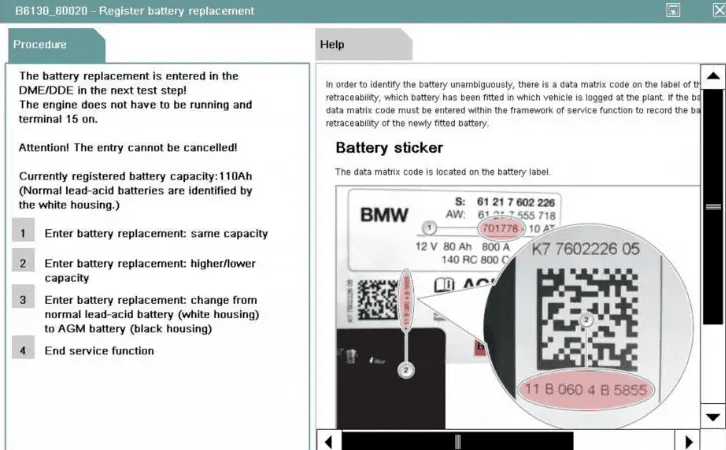
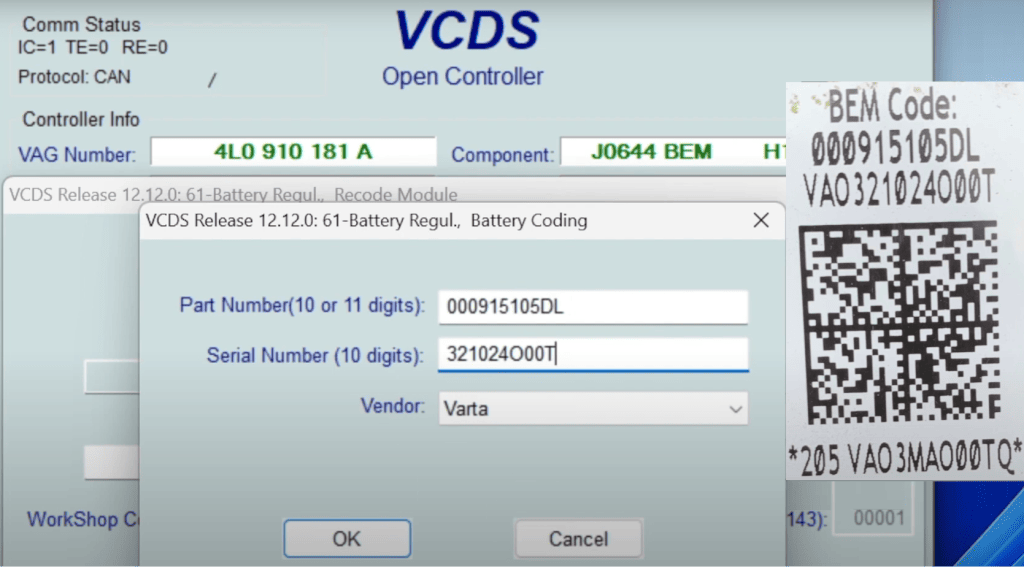
Diagnosis on the intelligent battery sensor:
The intelligent battery sensor communicates with the alternator and the BCM or engine control unit. This section explains how to read the diagram and how a diagnosis can be made.
In the following diagram we see the battery sensor (A85) which is supplied with a supply voltage of 2 volts by a fuse on pin 12. Pin 1 is for communication: from here a message is sent via LIN bus to the gateway (A25di) and the alternator (O01). Pins 1 and 2 are located in the two-pin plug visible in previous images.
The bottom two black wires on the battery sensor do not have a pin number: this is a direct connection to the negative terminal of the battery.
The intelligent battery sensor sends a LIN bus message to the gateway and the alternator. The gateway is the junction between networks with different protocols (voltages and speeds). In the gateway, the LIN bus message is sent via CAN bus to the BCM and/or engine control unit. Conversely, one of these two control devices controls the alternator via the gateway and LIN bus.
A fault in the LIN bus communication can mean that the battery sensor data cannot be used, or that the alternator is not controlled properly. In the latter case, the alternator switches to an emergency program in which the conventional D+ control is used to create sufficient charging voltage and charging current.
The tension course of the LIN bus signal can with one oscilloscope are measured for assessment.
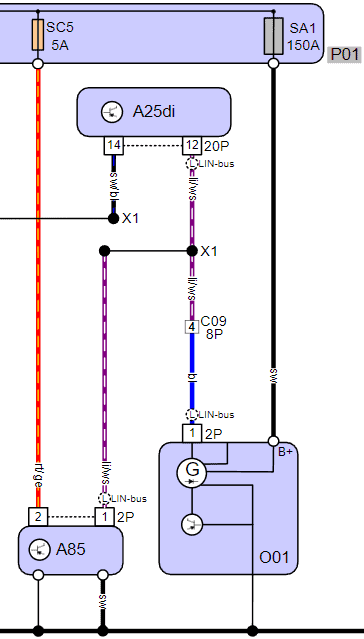
Description:
P01: engine compartment fuse box
A25di: diagnostic interface (gateway)
A85: ECU battery sensor
O01: dynamo
When there is a fault and the LIN bus communication is OK, we know that the supply voltage and ground of the sensor are good. The fault is caused by one of the components in this diagram. The following steps can be taken:
- check for software updates of the control devices;
- Test 12 volt battery (preferably under load);
- check whether the correct battery data has been registered. The battery may have been replaced in the past, but the registration was never carried out;
- reset the battery sensor data;
- check that the part number of the alternator is correct: an incorrect alternator that does not match the sensor will eventually cause problems;
- If the above has been checked and found to be correct, it may be possible to conclude that the battery sensor is defective. This sometimes occurs with frequent (incorrect) starting via jumper cables or a battery booster.
Related pages:
